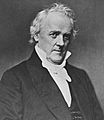Ostend Manifesto facts for kids
The Ostend Manifesto was a secret document written in 1854 by U.S. diplomats. It described a plan to get Cuba from Spain. The document said that "Cuba is as necessary to the North American republic as any of its present members." It also stated that Cuba "belongs naturally to that great family of states of which the Union is the Providential Nursery."
This document was created by three U.S. diplomats. They were James Buchanan, John Y. Mason, and Pierre Soulé. They were asked by U.S. Secretary of State William L. Marcy to come up with a plan. Their idea was to buy Cuba for $130 million. If Spain said no to the offer, the manifesto suggested that America would be "justified in wresting" (taking by force) Cuba from Spain.
The document was sent back to the U.S. State Department. But news of it leaked out, and it quickly became public.
Contents
What Was the Ostend Manifesto?
The Ostend Manifesto was a secret plan made in 1854. It was written by American diplomats in Ostend, Belgium. The main goal of this plan was for the United States to get control of Cuba.
A Secret Plan for Cuba
The plan was put together by three important U.S. officials. They were James Buchanan, who was the minister to Britain, John Y. Mason, the minister to France, and Pierre Soulé, the minister to Spain. They were told to create this plan by William L. Marcy, who was the U.S. Secretary of State.
Their secret plan was to offer Spain $130 million to buy Cuba. The document also said that if Spain refused to sell Cuba, the United States would be right to take it by force. This part of the plan was very strong and direct.
Why It Caused Trouble
When the document became public, it caused a lot of anger. Many people in the Northern states of America were upset. They felt it was a way for the Southern states to expand slavery. Pierre Soulé was known for supporting slavery, which made the situation worse.
People who were against slavery, called free-soilers, were already worried. They had recently been upset by the Fugitive Slave Law. This law was part of the Compromise of 1850. These groups called the Ostend Manifesto a "manifesto of brigands," meaning a plan made by criminals. Because of all this anger and disagreement, the American plan to get Cuba failed.
What Happened Next?
The idea of the United States getting involved in Cuba came up again much later. This happened near the end of the 1800s. It led to the Spanish–American War.
Images for kids
-
James Buchanan is believed to have authored the document.
See also
 In Spanish: Manifiesto de Ostende para niños
In Spanish: Manifiesto de Ostende para niños




